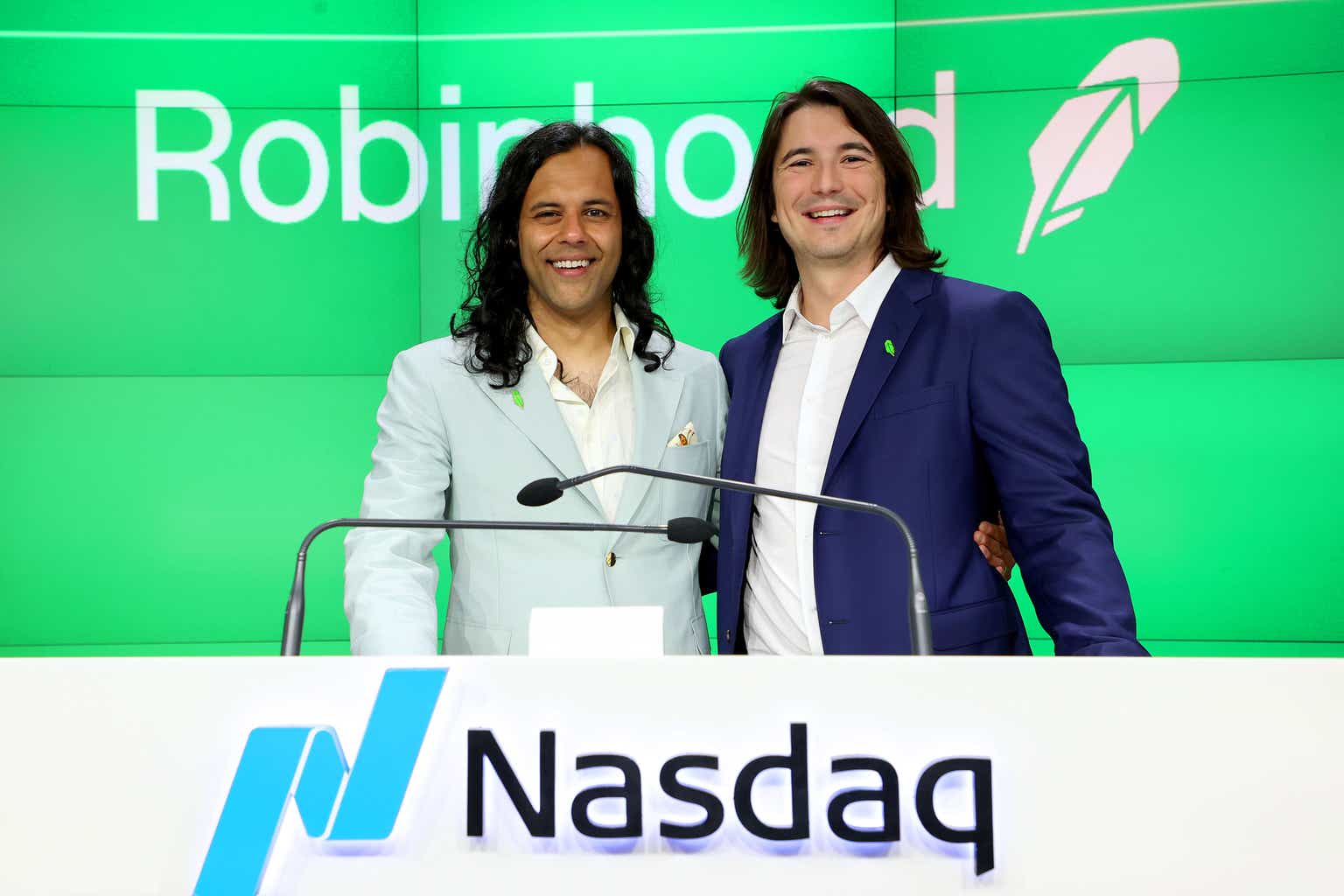Introduction
Robinhood Markets Inc. (NASDAQ:HOOD) is a financial services company known for its online brokerage platform: Robinhood. With a focus on accessibility and user-friendliness, Robinhood aims to attract beginner investors, offering trading options in stocks, options, and cryptocurrencies. While the platform gained significant popularity in 2020-2021 for its revolutionary efforts toward commission-free trading and gamifying the investment experience, recent scrutiny and user retention challenges have led to a significant decline in the company’s stock price, down over 70% from its IPO price of $38.
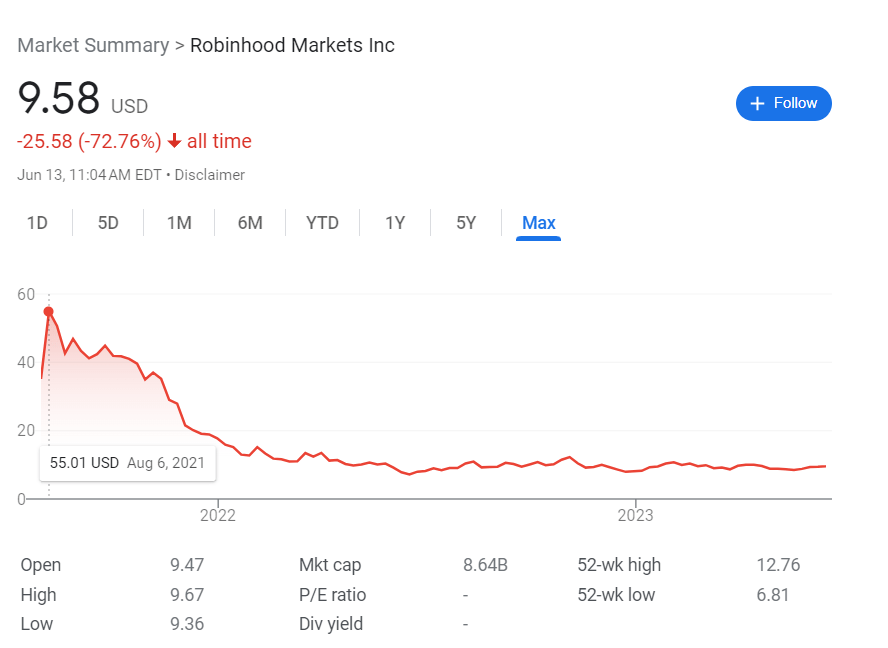
Google Finance
During the pandemic, Robinhood experienced a peak in popularity, leveraging factors such as increased leisure time, stimulus packages, its recognizable brand, and a user-friendly trading platform with zero commissions. Between December 2020 to 2021, Robinhood witnessed remarkable growth with an 89% increase in revenue and a 48% rise in monthly active users, reaching 17.3 million. While its growth was further propelled by “meme” stocks such as AMC and GameStop, Robinhood’s reliance on beginner retail traders became a vulnerability as competitors like Charles Schwab (SCHW), Fidelity, and TD Ameritrade also adopted zero-commission models alongside more robust features and tools. In spite of the uncertainties surrounding Robinhood’s business model, particularly for experienced traders, the current trading price of $9 could offer promising prospects for long-term growth if the company successfully addresses its key issues and continues to drive innovation. Therefore, it is recommended to hold the stock while closely monitoring Robinhood’s progress in innovation amidst its changing macroclimate.
Headwinds and Concerns
1. Exploitation of risky consumer behavior. Robinhood’s innovative approach to investing is primarily characterized by gamification, manifested through its user-friendly mobile interfaces and captivating visual elements, such as effects like confetti and appealing text styles and color palettes. Though this was a novel way to get beginners into investing, this approach tends to overlook the fact that users often perceive Robinhood as a game rather than a serious investment platform with real-life consequences. According to a research paper by FINRA in 2020, Robinhood users “traded nine times as many shares as E-Trade customers, and 40 times as many shares as Charles Schwab customers.” Robinhood’s idea of democratizing finance has omitted key points about due diligence and careful risk management, as highlighted by Robinhood’s careless advertisement that “We are all investors… you don’t need to become an investor. You were born one.” during the Superbowl. This failure by Robinhood to emphasize the significance of due diligence and market experience in its advertising mislead many unaware traders into an illusion of control and directly contradicted Robinhood’s commitment to safety. In addition, the prevailing confidence among investors during the bullish market rally of 2020-2021 only served to exacerbate the situation, as many individuals fell victim to the Dunning-Kruger effect and hastily created trading accounts in a frenzy in pursuit of quick gains. While this combination of factors led to a temporary growth environment for Robinhood, concerns about Robinhood’s business model and future profitability have undoubtedly risen. At a fundamental level, Robinhood relies on transaction-based revenue and payment for order flow (PFOF), primarily generated through frequent, often risky, trades. As seen in its report for transaction-based revenues, between 2020 and 2022, its percentage of transaction-based revenues from risky assets such as options and cryptocurrencies have grown from around 65% to a staggering 85% in 2022. While this certainly allowed Robinhood to thrive during the pandemic, the decrease in retail trading volume as a result of the end of the bull run has put a significant dent in Robinhood’s revenue growth. In Q1 of 2023, Robinhood’s monthly average users now sit at 11.8 million, down almost 50% from its peak in Q2 of 2021. While Robinhood’s recent earnings report indicates a stabilization of its monthly active users (MAU), challenges still lie in sustaining revenue growth amid a slowdown in transaction-based revenue and increased customer churn.
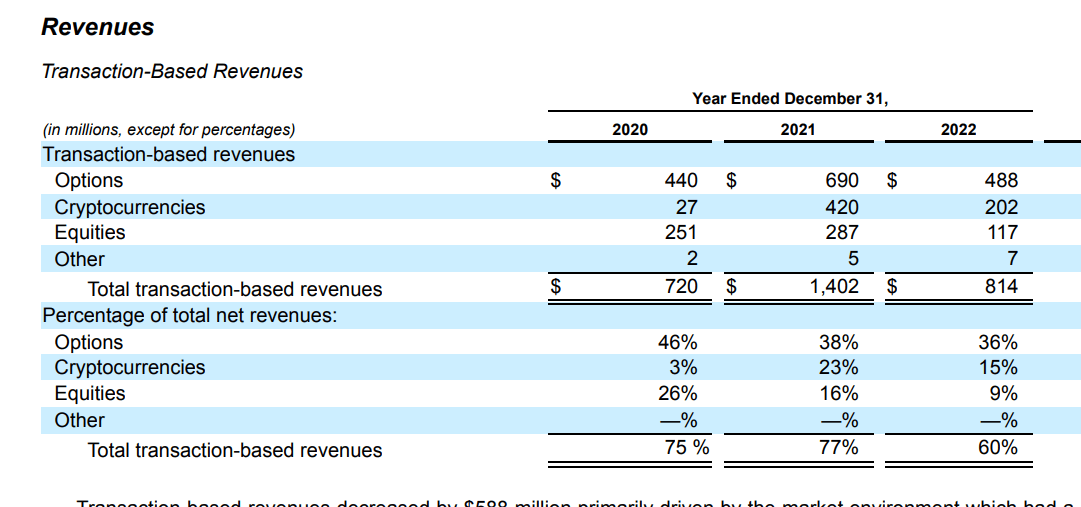
Robinhood
2. Retail vs Institutional Interests. In order to grow, Robinhood must maintain the balance between the interests of retail and institutional traders. While increased retail traders and executions allow for more popularity for Robinhood, Robinhood must also take into account the interests of its order flow buyers. Interestingly, Robinhood’s unique brand identity, centered around the concept of redistributing wealth, contradicts its main revenue growth method. Taking a look at Robinhood’s main market maker, we see that Citadel Securities LLC has long been Robinhood’s largest buyer for order flow, and its own performance is evident by being one of the world’s top leading hedge funds. Even if Robinhood attempts to promote the idea of “democratizing finance” and benefiting retail traders, its brand identity is limited by the fact that it still must uphold large institutions in its decision-making.

Robinhood
The main concern about the balance of interests boiled down during the GameStop short squeeze when Robinhood temporarily restricted users from buying GameStop (GME) and other meme stocks like AMC (AMC) and Nokia (NOK). While Robinhood had clear reasons to freeze it, mostly due to liquidity and settlement/clearance concerns, bad PR, and a twisted narrative spread among many Robinhood users. Many customers felt betrayed, believing that Robinhood was colluding with large institutional firms to protect corporations that suffered substantial losses during the short squeeze. The quote by Robinhood that “The rich don’t get a better deal” received a flurry of whiplash, leading to many retail traders angrily leaving Robinhood, believing them to be a traitorous scheme with malicious involvement with hedge funds. Despite the real reasons for the freeze, given that Robinhood’s main customer base is young easily influenced individuals, it’s clear that this incident led to Robinhood’s tarnished reputation. In the weeks following this incident, negative reviews on the app bombarded app stores, and its effects are highlighted by Robinhood’s clear drop in MAU and overall profitability. Furthermore, Robinhood’s previous fine by the SEC in 2020 for not providing customers with the best order fills, and prioritizing institutions, only served to further amplify customer resentment. With the drop in transaction-based revenues, Robinhood has to look for more diverse revenue streams while its reputation is covered, or else it will continue to have short-term profitability issues.
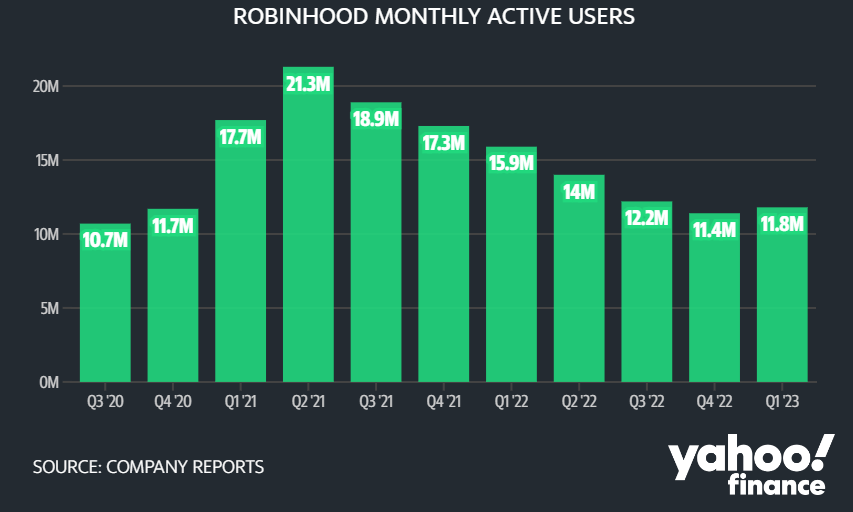
Yahoo Finance
3. Weakening competitive edge. Robinhood’s main competitive edge lay in its brand identity, interface, and movement into cryptocurrency. However, due to weak corporate effectiveness in dealing with financial responsibility, and also a business model that seems to only attract speculators and gamblers rather than genuine investors, its ability to stay a step ahead of its competitors seems uncertain. This can also largely be seen in the portfolio holdings of an average Robinhood trader. In 2022, Robinhood’s users average portfolio size was only $2,695, a steep drop from its average reported by FINRA in 2020. FINRA also reported that in 2020, the average age of a Robinhood user was 31, with half identifying as first-time investors. Taking into account the right skew of average incomes, we see a median customer account size of approximately $240. While its interface is visually appealing, its lackluster tools as compared to TD Ameritrade or Fidelity make Robinhood less appealing to serious investors. One of Robinhood’s attempts to attract more customers was by implementing more accessibility to cryptocurrency. The main method was to allow customers the ability to easily access dollar-cost average cryptocurrencies. However, with the steep 50% drop in Bitcoin’s value and the subsequent collapse of the FTX exchange magnifying concerns over the volatility and risk of cryptocurrencies, mounting regulatory scrutiny has further intensified and decreased the effectiveness of Robinhood’s strategy. While Robinhood may be able to still stay afloat by procuring beginner investors, steps toward securing long-term customers are needed before I can comfortably stand behind a BUY recommendation.
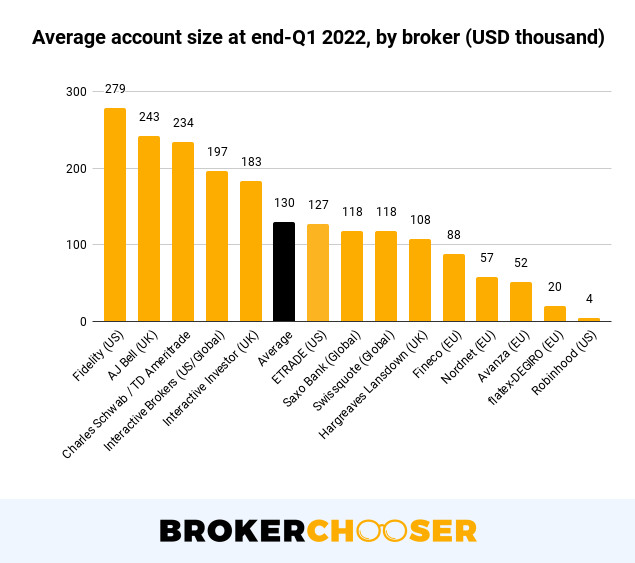
BrokerChooser
Potential Catalysts and Growth Drivers
While Robinhood currently faces various short-term issues that have impacted its reputation and growth, its low share price of only $9 presents significant upside growth potential. Despite concerns about Robinhood’s business model and the current unfavorable macroeconomic climate, the company has been introducing new products that could fuel long-term growth. At the forefront of potential growth drivers, we see Robinhood being the first brokerage to release 24-hour trading, allowing customers to trade individual stocks at their convenience. Similar to how zero commissions revolutionized the industry, this innovation has the potential to increase retail trading volume and provide a foundation for stabilizing Robinhood’s transaction-based revenues. Additionally, Robinhood’s expansion into offering IRA portfolio recommendations and retirement plans may contribute to growth, although the impact in this area seems limited until the company addresses its core customer retention issues. Continuing on with its 2023 roadmap, Robinhood has seen advances in potential advisory systems and pushes for more cryptocurrency use through Robinhood Connect and Wallet. While I remain a skeptic regarding these two potential drivers, in the long term, Robinhood’s vertically integrated business model may be able to develop these two into revolutionary tools. Voicing my concerns about these catalysts, I find it hard to currently support the push toward personalized advisory systems on a large scale, as automated advisory systems don’t seem completely viable for larger accounts, and would likely only push a minimal amount of demand from beginner investors. Similarly, while cryptocurrency is providing a good amount of transaction revenues and may revolutionize the future to provide some long-term support, for now, it seems too volatile and risky to completely support it. While the potential expansion into the UK and a potential license for futures trading may also help Robinhood’s recovery, I would first like to see how Robinhood stabilizes its metrics as interest rate hikes begin to slow down and a potential recession comes near.
Financial Analysis
Taking a closer look at ‘s Robinhood’s financials, we see a company whose market capitalization has steeply fallen off from its peak of 59.84 B and is now sitting at a mere 8.66 B. While this steep drop in market valuation is also reflected in the drop in revenue from 1.815B to 1.358B between 2021 and 2022, this quarter, we see that revenue has begun to stabilize a little, and Robinhood even exhibited a net revenue increase by 16% QOQ. This recovery in revenue is expected to continue, with analysts projecting its annual revenue to continue growing at a comfortable 12.8%. Despite the net revenue growth, its key to note that this past year, transaction-based revenues actually decreased by around 5%, and the net revenue was supported by the drastic increase of net interest revenues by 278% due to interest rate hikes this past year. While the interest revenue growth is making up for the lack of transaction-based revenues, as interest rates die down, the viability of relying on it for stability becomes less certain.

Robinhood
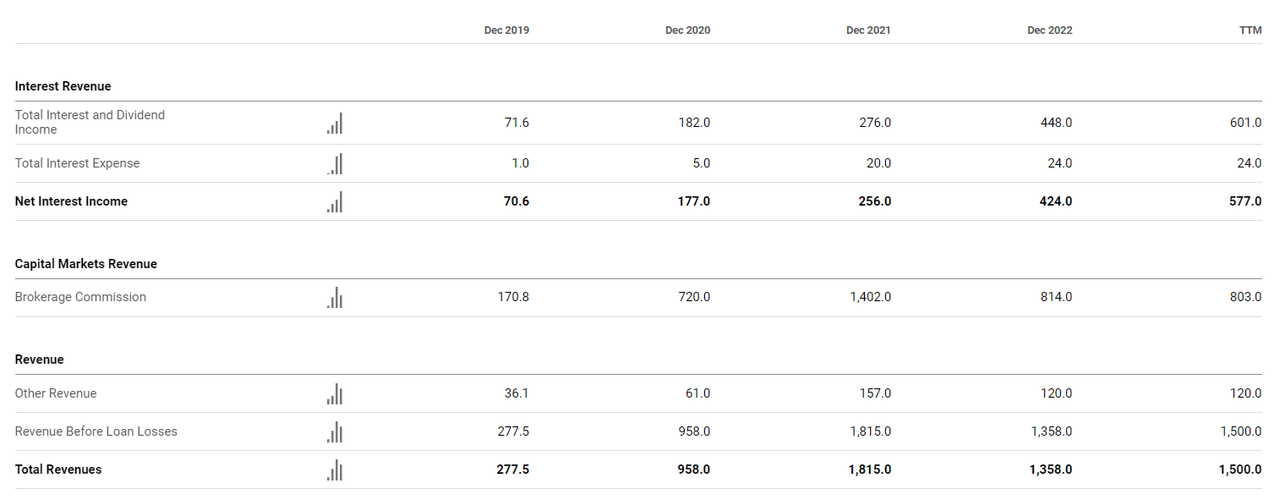
Seeking Alpha
While revenue growth is seemingly starting to recover, it’s key to note that Robinhood has, and is continuing to be, operating at a net income loss. Net loss this quarter was $511 million, an increase of $345 million from Q4 of 2022. While this loss was argued to be larger due to the cancellation of the 2021 founders award cancellation, the cancellation of the award to the founders will hopefully allow Robinhood to stay aloft lower GAAP operating costs, and increase investor demand by decreasing the diluted share count.
Despite this move, I still am wary of Robinhood’s moves in share-based compensation, especially when we see that since its IPO, Robinhood’s shares outstanding have only continued to grow at a steady rate. With the recent earnings report expecting a share-based compensation for the full 2023 year to be in the range of $925 million to $1.005 billion, and no signs of consistent share buybacks, I can only worry about the profitability and value of Robinhood as an investor.
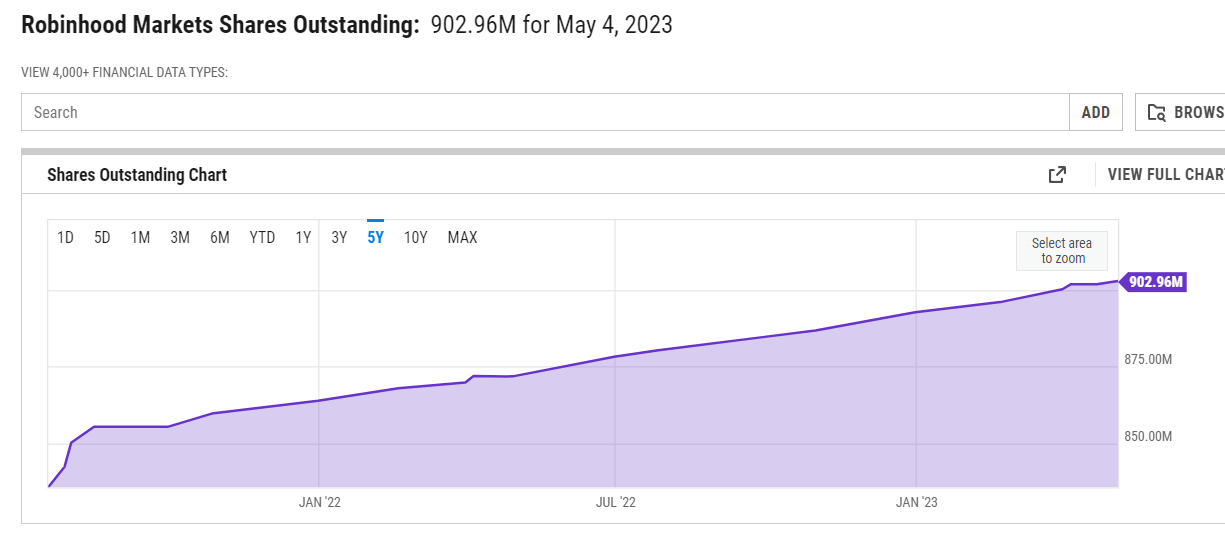
Yahoo Finance
To finish this financial analysis, it’s important to take a look at some of Robinhood’s key performance metrics this quarter. From the 2023 Q1 report, NCFA and MAU seemed to stabilize with a small boost in growth to both of them by about 120,000 and 400,000, respectively. Net deposits and AUC surprised me with growth rates of 29% and 26% respectively and can be traced back to an increasing number of customers incentivized by Robinhood Gold’s offer of 4.65% APY. With average revenue per user also increasing to $77, Robin hoods earnings are showing signs of recovery. However, with interest rates starting to ease, Robinhood must find a way to either increase its transaction-based revenue or garner a larger customer base, as growth will top out once ARPU starts to dwindle again.
Valuation
Despite my hesitance about the business model of the stock, the potential stabilization of its financial metrics, alongside the already low price of the stock, leaves little room to be pushed down further. First, taking a look at the book value of Robinhood, we see a price-to-tangible book ratio of only 1.25, a reasonable ratio given its historic high of 4.96. As of now, Robinhood’s stock price sits at $9.64, with a book value of $7.73. This highlights my point that despite the flawed business model, Robinhood’s share price has seemed to bottom out and its earnings only further push a potential trend reversal. Additionally, even though Robinhood’s P/E ratio has still historically remained negative, it’s worth noting that its NTM P/E ratio is estimated to be 21.33x, with EPS finally projected to be positive. While this is certainly still slightly overvalued compared to the sector median of 8.69x, it sits at a more attractive valuation than its historic values. Lastly, when looking at its EV/EBITDA ratio of 4.81x, we see that due to its exceptionally strong gross margins, its ratio outperforms over 84.63% in the software industry which has a median of 13.71x. Overall, we see that not only is it outperforming industries in terms of its EV/EBITDA ratio due to its remarkably low costs of revenue, but it also is highly discounted compared to historical values. While its lack of strong, clear catalysts leaves me a bit hesitant on giving this stock a complete BUY recommendation, given that we are stabilizing around its book value, there is no reason to give it a SELL either, and I suggest investors watch from the sidelines with an optimistic HOLD.
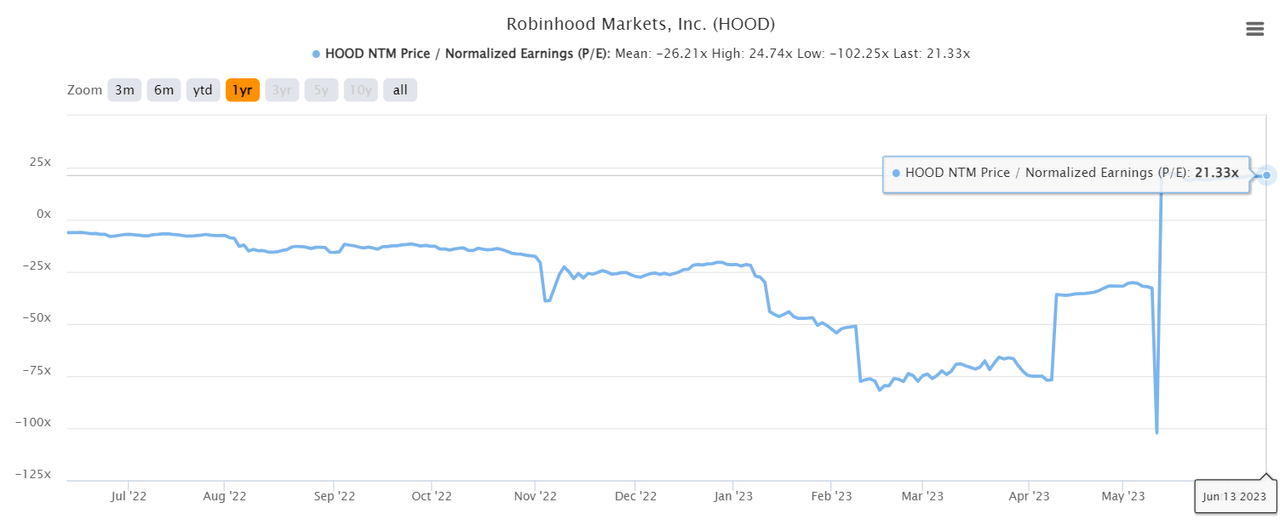
TIKR
ESG
As for Robinhood’s ESG rating, my sentiments are mixed. From Sustainalytic’s review, Robinhood operates at medium-high risk, edging out at a rating in around the 50th percentile for its industry.
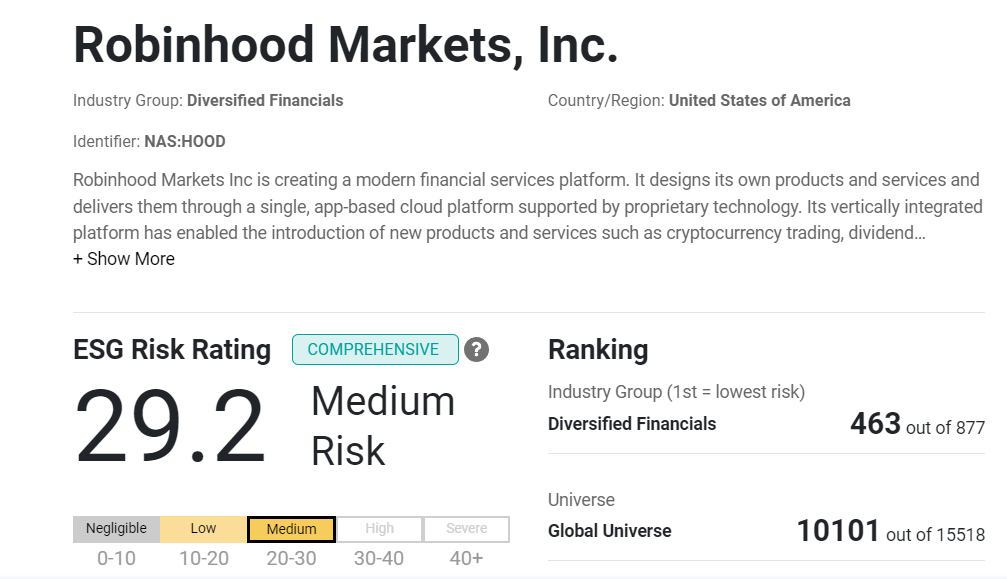
Sustainalytics
Taking a look further, while I do admire its recent efforts to push out financial literacy in the form of Robinhood Learn, Robinhood Snacks, and movements toward sustainability and environmental protection through carbon removal and emission reduction efforts, I still harbor reservations regarding Robinhood’s current stance on corporate and social responsibility. While financial responsibility is an important skill, Robinhood takes it too far by allowing users to too easily get their first hands experience in a field that has dangerous consequences. Its core business model of being a little guy that steals from the rich is questionable too, as it’s hard to fully advertise that while being in an industry that directly relies on those large institutional corporations. That being said, if Robinhood manages to effectively address its issues with corporate responsibility and takes measures to recover its reputation, I believe Robinhood can decrease its risk for ESG-conscious investors, and make them something worth investing in.
Bottom Line
In conclusion, while I remain cautious about Robinhood’s business model and past ESG issues, I recognize its potential for long-term success. With improving financial metrics and a well-executed roadmap, it appears that Robinhood’s stock is already nearing its bottom point and may show signs of a turnaround. Investors are advised to closely monitor next quarter’s earnings report to assess the company’s growth in the face of slowing interest rates and a potential recession. I recommend a cautious HOLD on Robinhood until further developments are observed, with the hope that the company will prioritize more ESG considerations in its future endeavors.
Analyst Recommendation: Ian Hartana
Read the full article here



